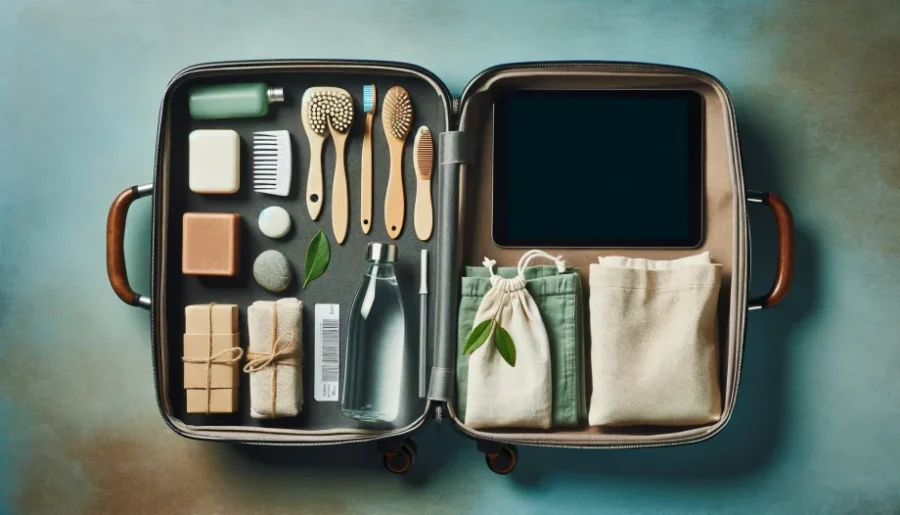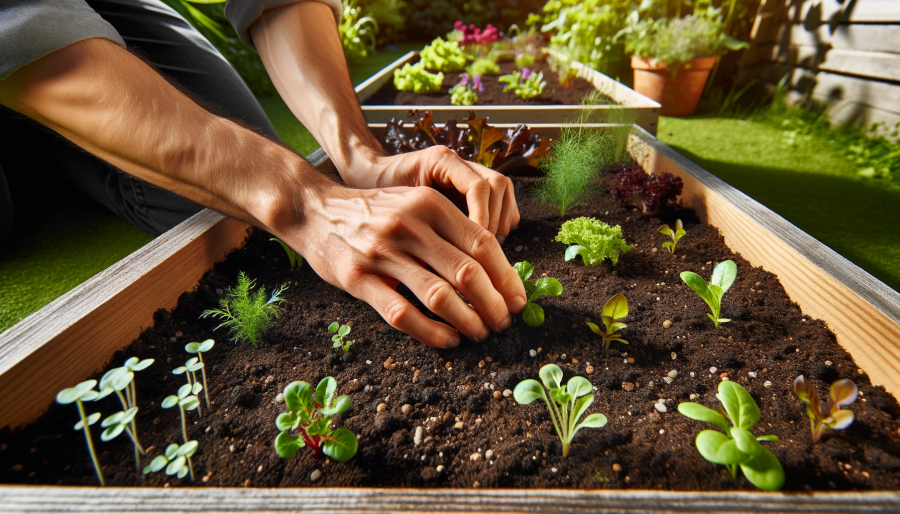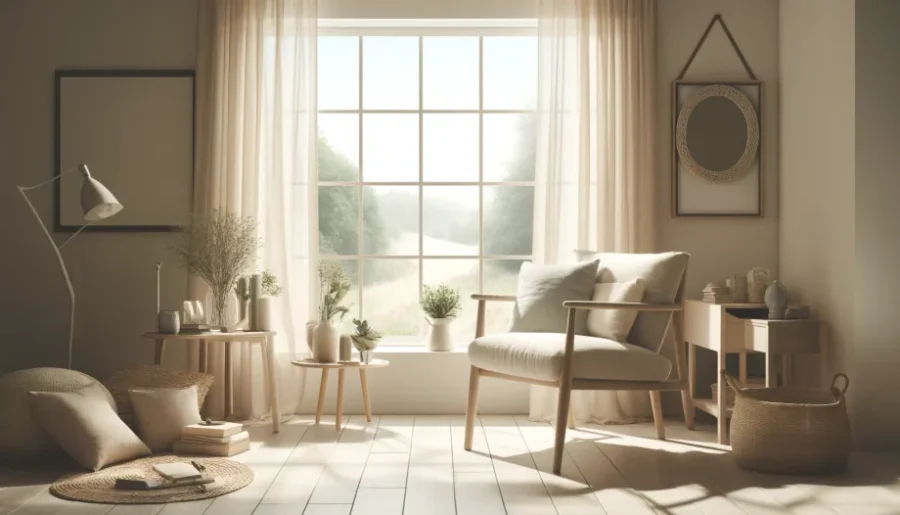
Embracing minimalism and sustainability can transform your everyday routine into a more mindful, fulfilling experience.
Have you ever wondered how to live a life that’s both simple and eco-friendly?
Let’s dive into how these two powerful concepts can help you declutter your life and make a positive impact on the planet.
Minimalism and Sustainability
Key Takeaways
- Minimalism and sustainability involve reducing excess and making mindful choices to benefit both personal well-being and the environment.
- Focusing on essential items and sustainable practices can declutter your life and reduce your ecological footprint, leading to a simpler, more eco-friendly lifestyle.
1. Introduction to Minimalism – Basics and Benefits

Minimalism is the practice of living with less to focus on what truly matters. It involves intentional living, reducing physical and mental clutter, and emphasizing experiences over material possessions.
History of Minimalism
Minimalism has roots in various cultures and philosophies, from the teachings of Buddha to modern-day influencers like Marie Kondo.
It gained popularity in the 1960s and 70s as a lifestyle choice that rejects consumerism in favor of simplicity and purpose.
Key Principles of Minimalism
- Intentionality: Make deliberate choices about what to keep and what to let go.
- Quality over Quantity: Invest in fewer, higher-quality items.
- Mindfulness: Stay present and focused on what truly matters.
- Simplicity: Reduce unnecessary complexity in your life.
Benefits for Mental Health and Well-being
Minimalism can significantly improve mental health by reducing stress and anxiety.
With fewer possessions to worry about, you can focus more on relationships and personal growth.
It creates a calmer, more organized living space, which can enhance overall well-being.
Benefits of Minimalism – Enhancing Life and Environment
Embracing minimalism can lead to a more fulfilling life with less stress and greater happiness.
It also promotes environmental sustainability by reducing waste and consumption.
Mental Health Benefits
Living with less can reduce the overwhelm and stress caused by clutter.
A tidy, minimalist environment can lead to a clearer mind, better focus, and increased productivity.
Minimalism encourages mindfulness and gratitude, contributing to overall mental well-being.
Environmental Impact
Minimalism helps reduce your ecological footprint. By buying less and focusing on sustainable products, you cut down on waste and conserve natural resources.
This lifestyle promotes recycling, reusing, and repurposing items, which benefits the planet.
Financial Advantages
Adopting minimalism can lead to significant financial savings. By avoiding unnecessary purchases, you can save money and reduce debt.
Investing in quality items that last longer means spending less over time.
This financial freedom can allow you to focus on experiences rather than material goods.
2. Decluttering Tips – Sustainable Home Organization
Sustainable decluttering is about removing excess items in a way that benefits both you and the environment. Learn how to declutter your home effectively and responsibly.
Decluttering Strategies
Start small and focus on one area at a time, such as a drawer or a closet. Set goals and deadlines to keep yourself motivated.
Use the “one in, one out” rule: for every new item you bring into your home, remove an old one.
Regularly assess your belongings to ensure everything has a purpose and brings joy.
Recycling and Donating Items
Instead of throwing away unwanted items, recycle or donate them. Many charities accept gently used clothes, furniture, and household goods.
Check local recycling guidelines for items like electronics and batteries. Websites like Freecycle and Craigslist are great for giving away items to someone who might need them.
Maintaining a Clutter-Free Home
To maintain a clutter-free home, establish regular habits such as tidying up daily and doing a monthly declutter sweep.
Create designated spaces for everything, so it’s easier to keep things organized.
Stay mindful of your purchases and avoid impulse buying to prevent clutter from building up again.
By following these sustainable decluttering tips, you can create a more organized, eco-friendly home that enhances your well-being and helps protect the environment.
3. Mindful Consumption – Reducing Waste Through Thoughtful Choices

Mindful consumption encourages us to buy only what we need, reducing waste and supporting sustainable practices.
It helps in creating a more intentional and eco-friendly lifestyle.
Conscious Shopping Habits
Start by evaluating your needs versus wants. Make a shopping list before going to the store to avoid impulse buys.
Choose products with minimal packaging and prefer reusable or recyclable options.
Opt for second-hand items when possible, and consider the product’s lifecycle before purchasing.
Sustainable Brands and Products
Support brands that prioritize sustainability and ethical practices. Look for certifications like Fair Trade, USDA Organic, and B Corp, which indicate higher standards of production.
Research companies to ensure they follow eco-friendly practices, such as using renewable energy, reducing emissions, and avoiding harmful chemicals.
The Impact of Consumer Choices
Every purchase decision impacts the environment. By choosing sustainable products, you reduce waste and conserve resources.
For instance, buying local reduces transportation emissions, and opting for organic products supports farming practices that are better for the soil and water.
Being mindful of your consumption habits helps promote a more sustainable future.
By adopting mindful consumption, you can significantly reduce your environmental footprint and contribute to a healthier planet.
4. Capsule Wardrobes – Minimalist and Sustainable Fashion
A capsule wardrobe consists of versatile, high-quality pieces that can be mixed and matched.
This approach promotes sustainability by reducing the need for frequent purchases.
Essentials of a Capsule Wardrobe
A capsule wardrobe typically includes timeless basics like a white shirt, black pants, a versatile dress, and comfortable shoes.
Each item should be durable and made from quality materials. Choose neutral colors that can be easily paired with other pieces, and aim for about 30-40 items in total.
Benefits for the Environment
Capsule wardrobes help reduce waste and pollution by minimizing the need for fast fashion.
Fewer clothes mean less energy and resources used in production, and quality items last longer, reducing the number of garments that end up in landfills.
This approach also encourages the purchase of sustainable and ethically made clothing.
Tips for Creating Your Own
- Assess Your Lifestyle: Consider your daily activities and the climate you live in to determine what pieces you’ll need most.
- Declutter: Remove items from your closet that you rarely wear or don’t love.
- Invest in Basics: Start with essential items that can be worn in multiple ways.
- Mix and Match: Choose pieces that complement each other and can create various outfits.
- Quality Over Quantity: Invest in durable, high-quality items that will last longer.
By adopting a capsule wardrobe, you can simplify your daily choices, reduce your environmental impact, and focus on wearing clothes that truly make you feel good.
5. Minimalist Home Design – Eco-Friendly Interiors

Minimalist home design focuses on simplicity, functionality, and sustainability.
It involves using fewer but higher-quality items to create a serene and eco-friendly living space.
Principles of Minimalist Design
Minimalist design emphasizes clean lines, open spaces, and a lack of clutter.
The goal is to create a peaceful environment with only the essentials.
This approach often involves a neutral color palette, natural light, and a focus on the functionality of each item.
Sustainable Materials and Furniture
Choosing sustainable materials is key to eco-friendly interior design.
Opt for furniture made from reclaimed wood, bamboo, or recycled materials.
Natural fabrics like organic cotton, linen, and wool are excellent for textiles.
Avoid plastics and synthetic materials that can be harmful to the environment.
Look for furniture brands that prioritize sustainability and ethical production practices.
Creating Functional Spaces
Each room should serve a clear purpose and be free from unnecessary items.
Multifunctional furniture, such as a sofa bed or a dining table that doubles as a workspace, can help maximize space.
Storage solutions like built-in shelves or under-bed drawers keep clutter out of sight.
Keeping the design simple and functional not only enhances the aesthetic but also contributes to a more organized and efficient home.
By integrating minimalist principles and sustainable choices into your home design, you create a space that is both beautiful and environmentally friendly.
This approach not only reduces your ecological footprint but also promotes a more peaceful and purposeful living environment.
6. Minimalist Living Spaces – Functionality and Simplicity
Minimalist living spaces are designed to maximize functionality and simplicity. They promote a clutter-free environment that enhances mental clarity and comfort.
Layout and Space Optimization
A well-thought-out layout is crucial in minimalist design. Focus on open spaces and easy flow between areas.
Arrange furniture to create clear pathways and use vertical space for storage.
Built-in cabinets and wall-mounted shelves can help keep surfaces clear and maintain an organized look.
Multifunctional Furniture
Investing in multifunctional furniture is key to maximizing space in a minimalist home.
Consider pieces like a sofa bed, a foldable dining table, or a storage ottoman.
These items serve multiple purposes and help reduce the number of furniture pieces needed, keeping your space simple and uncluttered.
Minimalist Decor Ideas
When it comes to decor, less is more. Choose a few high-quality pieces that you love rather than filling your space with many items.
Stick to a neutral color palette and natural materials to create a calm and cohesive look.
Incorporate plants for a touch of nature and use mirrors to enhance the sense of space and light.
By focusing on functionality and simplicity in your living spaces, you create an environment that is both practical and aesthetically pleasing.
This approach not only makes your home more efficient but also contributes to a sense of peace and clarity in your everyday life.
7. Minimalist Kitchen – Simplifying and Sustaining

A minimalist kitchen is free of excess gadgets and clutter, focusing on essential tools and sustainable practices. This approach leads to a more efficient and enjoyable cooking experience.
Essential Kitchen Tools
A minimalist kitchen relies on a few high-quality tools that serve multiple purposes.
Essentials include a sharp chef’s knife, a sturdy cutting board, a set of measuring cups, a versatile skillet, and a large pot.
Avoid single-use gadgets and opt for tools that can handle various cooking tasks.
Sustainable Cooking Practices
Sustainable cooking involves using ingredients that are local, organic, and in season.
Reduce food waste by planning meals, storing leftovers properly, and composting scraps.
Choose reusable items like cloth napkins and glass storage containers instead of disposable ones.
Cooking at home also reduces the carbon footprint compared to eating out or ordering takeout frequently.
Organizing for Efficiency
Keep your kitchen organized by designating specific areas for different tasks, such as prep, cooking, and cleaning.
Use drawer dividers and shelf organizers to keep tools and ingredients easily accessible.
Store items you use most frequently in convenient locations, and periodically declutter to maintain a tidy space.
By focusing on essential tools, sustainable practices, and efficient organization, a minimalist kitchen can enhance your cooking experience and contribute to a more eco-friendly lifestyle.
8. Minimalist Workspaces – Productivity in Simplicity

Creating a minimalist workspace helps boost productivity and reduce distractions.
A clean and organized environment can enhance focus and efficiency.
Desk Organization Tips
Start by keeping only essential items on your desk. Use storage solutions like drawer organizers and desk trays to keep supplies tidy.
Regularly declutter your workspace to remove unnecessary items. Label storage containers and designate specific areas for frequently used items to maintain order.
Ergonomic Furniture
Investing in ergonomic furniture can improve comfort and productivity.
Choose a chair that supports good posture and an adjustable desk that allows for both sitting and standing positions.
Proper ergonomics reduce strain and improve focus, making your workspace more efficient and comfortable.
Digital Decluttering
Keep your digital workspace as organized as your physical one. Regularly delete unnecessary files and emails.
Use cloud storage for important documents to free up space on your device.
Organize your desktop and folders for easy access to frequently used files, and consider using productivity apps to manage tasks and deadlines efficiently.
By applying these tips, you can create a minimalist workspace that promotes productivity and reduces stress.
A streamlined environment helps you focus on your tasks and achieve better results.
9. Digital Minimalism – Reducing Digital Clutter
Digital minimalism is about curating your online presence and managing technology use to reduce stress and improve mental well-being.
Managing Email and Notifications
Emails and notifications can be overwhelming if not managed properly.
Start by unsubscribing from unnecessary newsletters and setting up filters to prioritize important messages.
Limit how often you check your email to specific times of the day.
Turn off non-essential notifications to reduce distractions and maintain focus.
Social Media Detox
A social media detox can help you regain control over your time and attention.
Begin by assessing which platforms add value to your life and which don’t.
Set specific times for social media use, and consider deleting or deactivating accounts that cause stress or distraction.
Engage in activities that promote real-life connections and personal growth.
Organizing Digital Files
Keep your digital files organized by creating a logical folder structure. Regularly delete old or unnecessary files to free up space.
Use cloud storage to back up important documents and ensure they are accessible from any device.
Keep your desktop clear of clutter and use consistent naming conventions for easy retrieval.
By implementing these strategies, you can reduce digital clutter and create a more focused, stress-free online environment.
This not only improves your mental well-being but also makes your digital interactions more intentional and meaningful.
10. Minimalism for Families – Simplifying with Loved Ones
Adopting minimalism as a family can lead to stronger relationships and a more harmonious home.
It involves making conscious choices together and prioritizing quality time.
Family Activities that Foster Minimalism
Engage in activities that promote simplicity and togetherness. Family hikes, board games, and cooking meals together are great options.
These activities encourage spending quality time without the need for excessive material possessions.
They also foster communication and bonding, which are essential for a harmonious family life.
Simplifying Kids’ Toys and Clothes
Minimize the number of toys and clothes to reduce clutter and encourage creativity.
Choose versatile, durable toys that can be used in multiple ways. Rotate toys to keep things fresh without overwhelming your kids with options.
When it comes to clothes, opt for quality over quantity and involve your children in the process of selecting and donating items.
Communicating Minimalist Values
Teach children the importance of valuing experiences over things.
Discuss the benefits of minimalism and involve them in decluttering and organizing.
Use age-appropriate language and examples to explain why having fewer possessions can lead to more freedom and happiness.
Make it a family project to simplify and appreciate what truly matters.
By adopting minimalism as a family, you can create a supportive environment that emphasizes relationships and well-being over material possessions.
This approach not only strengthens family bonds but also instills valuable life lessons in children.
11. Minimalist Travel – Sustainable and Light

Minimalist travel involves packing light and making sustainable choices on the go.
It reduces stress and enhances the travel experience.
Packing Essentials
When packing for minimalist travel, focus on multi-purpose items.
Bring versatile clothing that can be layered, such as a lightweight jacket, comfortable shoes, and basic t-shirts.
Essential toiletries, a reusable water bottle, and a compact first-aid kit are must-haves.
Use packing cubes to organize and maximize space in your luggage.
Sustainable Travel Tips
Choose eco-friendly accommodations like hotels with green certifications or eco-lodges.
Opt for public transportation, biking, or walking instead of renting a car.
Bring your own reusable items, like a water bottle, shopping bags, and utensils, to reduce single-use plastics.
Support local businesses and eat at restaurants that prioritize sustainable practices.
Benefits of Traveling Light
Traveling light reduces the hassle of lugging around heavy bags and minimizes the risk of lost luggage.
It allows for greater mobility and flexibility, making it easier to navigate through airports and cities.
A lighter load also means fewer carbon emissions, as lighter planes and vehicles consume less fuel.
By embracing minimalist travel, you can enjoy a stress-free, eco-friendly trip that focuses on experiences rather than possessions.
This approach not only enhances your travel experience but also contributes to a more sustainable world.
12. Minimalist Gardening – Simple and Sustainable Green Spaces

Minimalist gardening focuses on creating low-maintenance, sustainable gardens that require fewer resources and bring peace and beauty to your space.
Choosing Low-Maintenance Plants
Opt for native plants that are well-suited to your climate, as they require less water and care.
Perennials, which return year after year, reduce the need for replanting.
Succulents and other drought-tolerant plants are excellent choices for a minimalist garden, as they thrive with minimal attention.
Sustainable Gardening Practices
Practice organic gardening by avoiding chemical pesticides and fertilizers.
Use compost and natural mulch to enrich the soil and retain moisture.
Collect rainwater in barrels to water your plants.
Implementing companion planting can naturally deter pests and enhance plant growth without relying on harmful chemicals.
Designing Minimalist Garden Layouts
Create a simple garden layout with clean lines and defined spaces.
Use geometric shapes for planting beds and pathways to keep the design straightforward and easy to maintain.
Limit the variety of plants to create a cohesive look and reduce the complexity of care.
Incorporate functional elements like raised beds or vertical gardens to maximize space.
By focusing on low-maintenance plants, sustainable practices, and simple designs, minimalist gardening can help you create a beautiful, eco-friendly garden that enhances your living space with minimal effort.
13. Minimalist Hobbies – Eco-Friendly Leisure Activities
Minimalist hobbies are activities that require minimal equipment and resources, promoting a sustainable and fulfilling lifestyle.
Examples of Minimalist Hobbies
- Hiking: Enjoy nature with just a pair of good shoes and a water bottle.
- Reading: A book or an e-reader is all you need for endless entertainment and learning.
- Gardening: Grow your own herbs and vegetables with minimal tools and space.
- Drawing or Sketching: A simple sketchbook and pencils can provide hours of creative enjoyment.
- Yoga: Requires just a mat and some comfortable clothes.
Benefits for Mental Health
Minimalist hobbies can significantly improve mental health by reducing stress and providing a sense of accomplishment.
Engaging in simple, mindful activities can enhance focus and relaxation.
These hobbies often promote physical activity and creativity, which are known to boost mood and mental clarity.
How to Get Started
- Choose an Interest: Identify hobbies that align with your interests and require minimal resources.
- Gather Essentials: Start with basic equipment or tools that you already have or can easily acquire.
- Make Time: Dedicate regular time to your chosen hobby to develop a routine.
- Enjoy the Process: Focus on the enjoyment and fulfillment that comes from the activity, rather than on acquiring more gear or achieving perfection.
By embracing minimalist hobbies, you can lead a more sustainable and rewarding lifestyle, finding joy and relaxation in simple, eco-friendly activities.
14. Minimalist Events – Planning Simple and Sustainable Gatherings
Planning minimalist events focuses on simplicity and sustainability, creating memorable experiences without excess.
Eco-Friendly Event Planning
Choose venues that prioritize sustainability, like parks or community centers. Use digital invitations instead of paper ones to reduce waste.
Decorate with reusable or biodegradable materials. For food, opt for locally sourced, organic ingredients, and avoid single-use plastics by using compostable or reusable dishware.
Minimalist Party Ideas
- Potluck Gatherings: Encourage guests to bring their favorite dish, reducing the host’s burden and food waste.
- Outdoor Picnics: Use natural settings for decoration and entertainment, minimizing the need for additional items.
- Themed Dinners: Focus on simple themes that require minimal decorations and can utilize items you already own.
Reducing Waste at Events
Plan portions carefully to avoid food waste. Set up recycling and compost bins to manage waste effectively.
Opt for digital music playlists and photo albums instead of physical copies.
Encourage guests to bring their own containers for leftovers, and use cloth napkins and tablecloths instead of disposable ones.
By incorporating these strategies, you can host minimalist events that are both enjoyable and environmentally friendly.
This approach not only simplifies the planning process but also promotes sustainability and reduces the environmental impact of your gatherings.
15. Minimalism and Mental Health – Benefits for Well-being

Minimalism can significantly improve mental health by reducing stress, anxiety, and promoting a sense of calm and clarity.
Psychological Benefits
Minimalism helps declutter both physical and mental spaces, which can reduce feelings of overwhelm and stress.
By focusing on fewer possessions and commitments, individuals can experience greater clarity and peace of mind.
Studies have shown that a tidy, organized environment can boost mood and productivity, contributing to overall well-being
Practices to Enhance Mental Health
- Declutter Regularly: Make it a habit to declutter your living space regularly. This can help maintain a sense of order and reduce mental load.
- Mindful Consumption: Be intentional about what you bring into your life, focusing on items and experiences that add value and joy.
- Simplify Your Schedule: Limit your commitments to those that are truly important to you. This helps reduce stress and allows more time for relaxation and personal growth.
Case Studies and Personal Stories
Many people have shared their transformative experiences with minimalism.
For example, Joshua Becker, a prominent minimalist advocate, discusses how reducing his possessions helped him focus on his family and personal goals.
Similarly, Courtney Carver’s journey into minimalism began as a way to manage her multiple sclerosis symptoms, leading to significant improvements in her physical and mental health
By adopting minimalism, you can create a more peaceful, focused, and fulfilling life, enhancing your mental health and overall well-being.
16. Sustainable Minimalism – Integrating Green Practices
Sustainable minimalism combines the principles of minimalism with environmental responsibility, leading to a lifestyle that is both simple and eco-friendly.
Sustainable Living Tips
- Buy Less, Choose Well: Focus on purchasing fewer, higher-quality items that last longer. This reduces waste and the frequency of replacement.
- Use Reusables: Opt for reusable bags, bottles, and containers instead of single-use plastics. This simple switch can significantly cut down on waste.
- Eco-Friendly Transportation: Use public transportation, carpool, bike, or walk whenever possible to reduce carbon emissions.
Reducing Carbon Footprint
Adopting a minimalist lifestyle can significantly reduce your carbon footprint.
By consuming less and choosing sustainable products, you reduce the demand for resources and energy used in manufacturing and transportation.
Simple practices like conserving water, using energy-efficient appliances, and supporting renewable energy sources also contribute to lowering your environmental impact.
Benefits for the Planet
Sustainable minimalism not only benefits individuals but also has a positive impact on the planet.
It helps reduce pollution, conserve natural resources, and decrease landfill waste.
By promoting a culture of mindful consumption and environmental stewardship, sustainable minimalism encourages broader societal shifts towards sustainability and ecological balance
By integrating green practices into your minimalist lifestyle, you can create a positive ripple effect that benefits both your well-being and the health of the planet.
17. Minimalism and Finances – Economic Advantages
Adopting minimalism can lead to significant financial benefits by reducing unnecessary expenses and promoting mindful spending.
Budgeting and Saving
Minimalism encourages you to focus on what truly matters, which helps in creating a realistic and effective budget.
By prioritizing essential expenses and cutting out non-essential purchases, you can save more money.
Track your spending to identify areas where you can cut back. This mindful approach to spending can lead to substantial savings over time
Financial Freedom through Minimalism
Living a minimalist lifestyle can pave the way to financial freedom.
With fewer financial obligations and a simpler lifestyle, you can pay off debt faster and build an emergency fund.
This financial cushion provides security and reduces stress, allowing you to pursue passions and opportunities without the burden of financial worry
Investing in Quality over Quantity
Minimalism teaches the value of investing in high-quality items that last longer.
While the initial cost may be higher, quality items reduce the need for frequent replacements, saving money in the long run.
This principle can be applied to various aspects of life, from clothing and furniture to technology and tools.
By choosing durability and functionality, you make smarter financial decisions that benefit both your wallet and the environment.
By embracing minimalism, you can achieve greater financial stability and freedom, allowing you to focus on experiences and goals that enrich your life.
This approach not only saves money but also promotes a more mindful and intentional way of living.
18. Minimalism in Education – Teaching Simplicity and Sustainability
Incorporating minimalism in education helps students focus, reduces stress, and promotes sustainable practices from an early age.
Minimalist Classroom Ideas
Creating a minimalist classroom involves reducing visual clutter and using a simple, functional layout.
Opt for multi-purpose furniture and keep decorations minimal. Digital tools can replace many physical resources, reducing paper waste and keeping the environment tidy.
Encourage students to keep their workspaces organized and free of unnecessary items.
Benefits for Students and Teachers
Minimalist classrooms can enhance focus and reduce distractions for students, leading to better academic performance.
For teachers, a simplified environment reduces the time spent on managing materials, allowing more time for instruction and interaction with students.
Both students and teachers benefit from a calmer, more organized space that fosters a positive learning atmosphere
Integrating Sustainability in Curriculum
Incorporating sustainability into the curriculum teaches students the importance of environmental stewardship.
Projects can include recycling programs, gardening, and lessons on energy conservation.
Encourage students to bring reusable containers and reduce waste.
Educators can integrate discussions on sustainable living and mindful consumption, helping students develop habits that support both minimalism and environmental responsibility
By embracing minimalism in education, schools can create environments that enhance learning and promote sustainable practices, preparing students for a mindful and eco-friendly future.
19. Minimalism and Wellness – Holistic Health Benefits
Minimalism contributes to overall wellness by promoting a balanced lifestyle, reducing stress, and enhancing physical and mental health.
Connection between Minimalism and Wellness
Minimalism encourages focusing on what truly matters, which can lead to reduced stress and anxiety.
By eliminating clutter and unnecessary commitments, individuals can create a more serene and organized environment, promoting mental clarity and emotional well-being.
This approach also fosters a sense of control and simplicity, which is beneficial for overall health
Practices for Holistic Health
- Declutter Regularly: Regularly removing physical clutter can create a peaceful living space, reducing stress and improving mental health.
- Mindful Consumption: Being intentional about purchases and avoiding unnecessary items can lead to financial stability and less mental burden.
- Simplify Your Schedule: Prioritizing essential activities and reducing overcommitment can lead to a more balanced and less stressful life.
- Engage in Minimalist Activities: Activities like meditation, yoga, and walking can promote physical health and mental relaxation without requiring much equipment or preparation.
Success Stories
Many individuals have shared their journeys towards minimalism and its positive impact on their wellness.
For example, Joshua Fields Millburn and Ryan Nicodemus, known as The Minimalists, found that reducing their possessions and focusing on meaningful experiences significantly improved their mental health and overall life satisfaction.
Similarly, blogger Courtney Carver adopted minimalism to manage her multiple sclerosis, leading to enhanced physical and emotional well-being
By embracing minimalism, you can achieve a holistic approach to wellness that supports both your physical and mental health.
This lifestyle promotes a balanced, stress-free environment, allowing you to focus on what truly brings joy and fulfillment.
20. Minimalism for Seniors – Simplifying in Later Life
Adopting minimalism in later stages of life can bring peace, reduce burdens, and allow seniors to focus on meaningful experiences.
Decluttering for Seniors
Seniors can benefit greatly from decluttering their living spaces.
Simplifying belongings reduces physical obstacles and makes homes safer, which is especially important for those with mobility issues.
Start with one area at a time, such as a closet or a drawer, and decide what to keep based on necessity and joy it brings.
Enlist help from family or friends to make the process easier and more enjoyable.
Benefits for Health and Well-being
Minimalism can lead to better mental and physical health for seniors. A clutter-free environment reduces stress and anxiety, making it easier to relax and enjoy daily life.
Fewer belongings mean less maintenance and cleaning, allowing more time and energy for hobbies and social activities.
This lifestyle also encourages mindful living and spending, which can improve financial health and reduce the burden of debt
Community and Support
Joining a community or support group focused on minimalism can provide motivation and companionship.
Many seniors find it helpful to share their experiences and strategies with others on the same journey.
Local community centers, online forums, and social groups can offer valuable resources and support.
Additionally, involving family members in the process can strengthen relationships and create a sense of shared purpose
By embracing minimalism, seniors can enjoy a more peaceful, focused, and fulfilling life, with fewer burdens and more time for the experiences and people that truly matter.
Minimalism and Sustainability Final Thoughts
Minimalism is more than just a trend—it’s a way of life that can bring immense benefits, from reducing stress and improving mental health to promoting sustainability and financial freedom.
Whether you’re looking to declutter your home, simplify your wardrobe, or create more meaningful experiences with your family, embracing minimalism can lead to a more fulfilling and intentional life.
By integrating minimalist principles into various aspects of your daily routine, you can enhance your well-being, support environmental sustainability, and focus on what truly matters.
Start small, stay consistent, and enjoy the profound impact that minimalism can have on your life. Check our category eco-minimalism for more.
Learn more about Minimalism Basics
Further reading:
Modern Minimalism
Becoming Minimalist
The Minimalists



